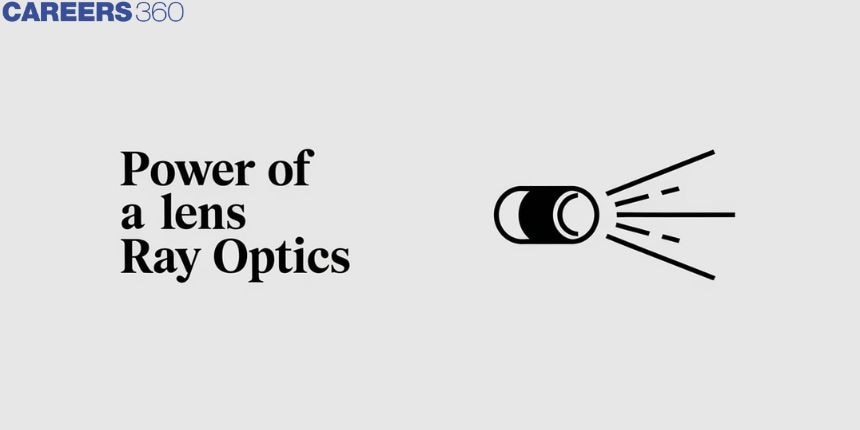Power of a Lens Ray Optics - Definition, Formula, FAQs
In this article, we are going to discuss a very important topic of class 10, the power of a lens. A lens is a piece of glass through which light is passed or refracted. Lens are used for fixing vision problems and other instruments that give man a better perspective on day to day things. In the below article, we will discuss the power of the lens for better understanding.
JEE Main/NEET 2027: Physics Important Formulas for Class 10
NEET 2025: Mock Test Series | Syllabus | High Scoring Topics | PYQs
JEE Main: Study Materials | High Scoring Topics | Preparation Guide
JEE Main: Syllabus | Sample Papers | Mock Tests | PYQs
- What is Lens?
- Power of a Lens
- Power of a lens Formula
- Relation between Refractive Index and Focal Length
- Solved Examples on Power of Lens

What is Lens?
A lens is a transparent magnifying curved glass through which light rays converge or diverge. Lenses are used in optical instruments such as cameras, microscopes, telescopes, and eyeglasses to manipulate light for various purposes. There are two types of lenses namely Concave lens and Convex lens.
Power of a Lens
We know that a convex lens converges the light rays incident on it but a concave lens diverges the incident light rays. The power of a lens is a measure of its ability to converge or diverge light rays that incident on it .
This ability is based on its focal length. It is found that a convex lens of shorter focal length bends the light rays through larger angles and focuses them closer to the optical center. Similarly, a concave lens of a smaller focal length produces more divergence than a lens of a longer focal length. This shows that the power of the lens is inversely proportional to the focal length of the lens.
Also read -
- NCERT Exemplar Solutions for All Subjects
- NCERT Notes For All Subjects
- NCERT Solutions for All Subjects
Power of a lens Formula
The power of a lens is mathematically defined as the reciprocal of its focal length.
Si unit of the power of lens is dioptre. It is usually denoted by the letter ‘d’.
Formula:
In SI Units:
Where:
Sign Convention for Lens
Convex Lens (Converging): Positive focal length
Concave Lens (Diverging): Negative focal length
|
Related Topics |
Relation between Refractive Index and Focal Length
Where:
Optics Formula
Lens Formula
Where:
-
-
-
Magnification for Lenses
Where:
-
-
-
-
-
Mirror Formula
Where:
-
-
-
Where:
-
-
-
Solved Examples on Power of Lens
1. A convex lens has a focal length of 0.5 meters. What is its power?
Solution:
Given
The power of the lens is
2. A lens has a power of -4 D . Find its focal length.
Solution:
Rearranging for
Given
The focal length is -0.25 m (negative sign indicates it is a concave lens).
3. A convex lens has a focal length of 50 cm. Find its power.
Solution:
Convert focal length to meters:
The power of the lens is
3. Two lenses of powers +3 D and -2 D are placed in contact. What is the resultant power?
Solution:
The resultant power is the algebraic sum of the individual powers:
Given
The resultant power is
Frequently Asked Questions (FAQs)
The sign conventions used for spherical lenses if the object is always placed to the left of the lens so that the light from the object falls to the lens from the left hand side
Oldest census parallel to the principal axis usually called x-axis are measured from optical lens is taken as the origin point
All distance is measured to the right of the origin along x axis are taken as positive but distance is measured to the left of the origin are taken as negative
Along the direction perpendicular to the principal axis usually called y- axis heights measured above the principal axis are taken as positive but height measured below the principal axis are taken as negative.
Lensometer is usually used in optical shops and hospital use.
Ray optics formulas are
Total internal refraction | n1n2 = sin(r) sin(i). n1n2=sin(r)sin(i) |
Critical angle, θ | sinθ=n2n1sinΘ=n2n1 |
Prism formula | μ=sinA+δm2sinA2μ=sinA+δm2sinA2 |
Lens maker formula | 1f=(μ−1)(1R1−1R2) |
Magnification produced by a lens gives the relative extent to which the image of an object is enlarged or diminished with respect to the object size for a linear object held normal to the principal axis of a spherical lens. The linear magnification or magnification is represented as the ratio of the image height to the object height.
M = h’/h
Magnification produced by a lens is represented in terms of distance of the object and the distance of the image. It is given by:
M = v/u.
Additive property of power of lenses is also used to design lens system so as to minimised search images produced by a single lens is commonly used in design of camera lenses and lenses of microscopes and telescopes this property is very convenient for opticians during eye testing.
Also Read
19 Jul'25 03:20 PM
02 Jul'25 07:56 PM
02 Jul'25 06:11 PM
02 Jul'25 05:17 PM
02 Jul'25 05:09 PM
02 Jul'25 05:08 PM
02 Jul'25 05:08 PM
02 Jul'25 05:07 PM
02 Jul'25 05:07 PM
02 Jul'25 05:04 PM

